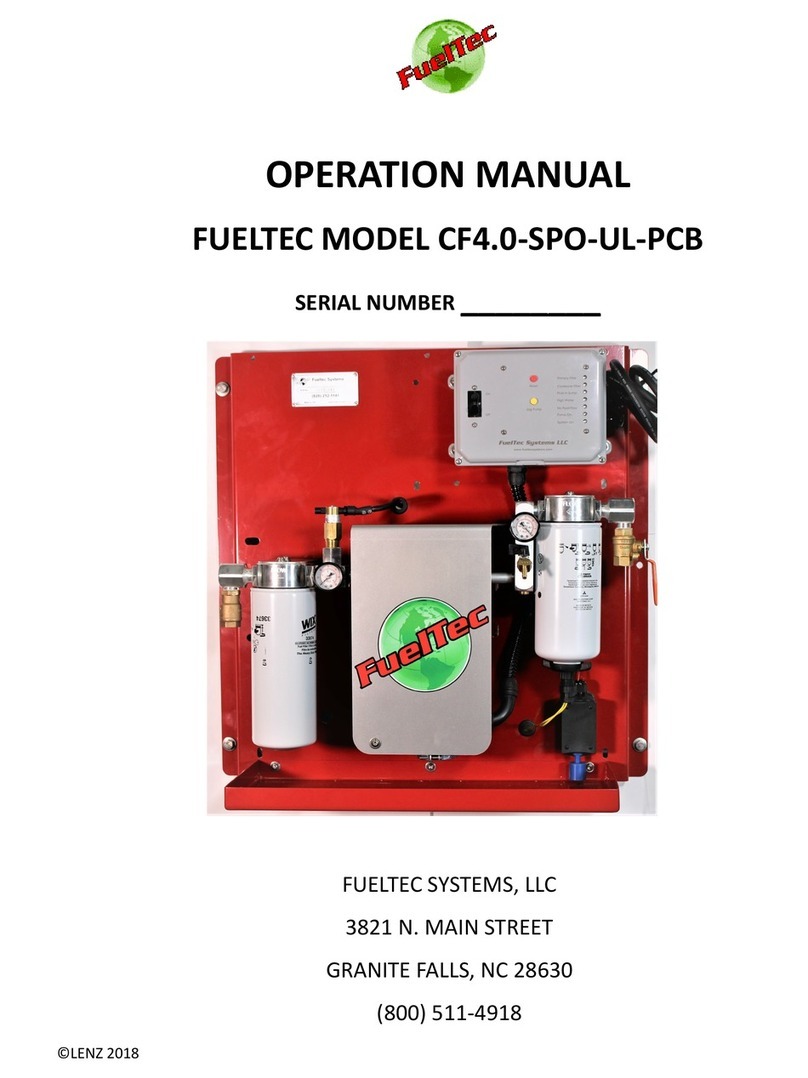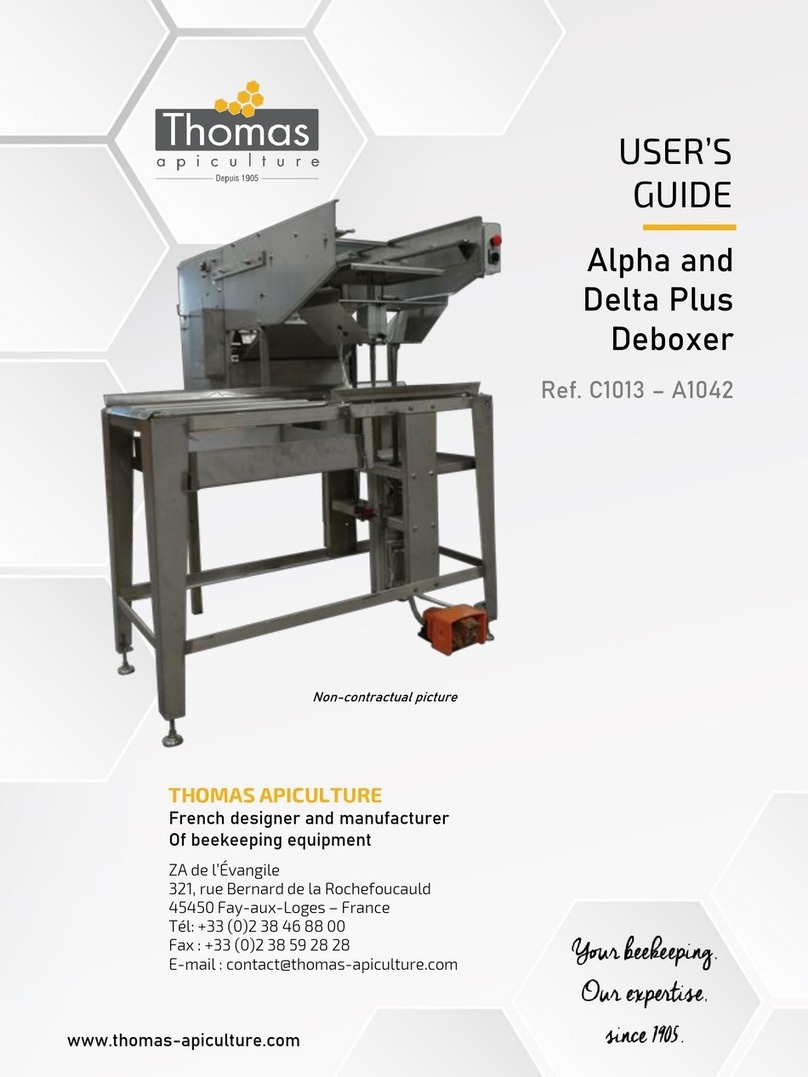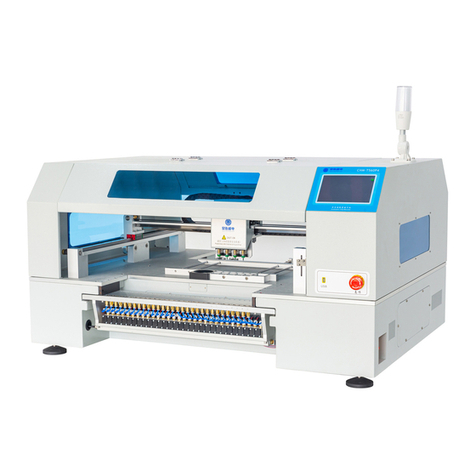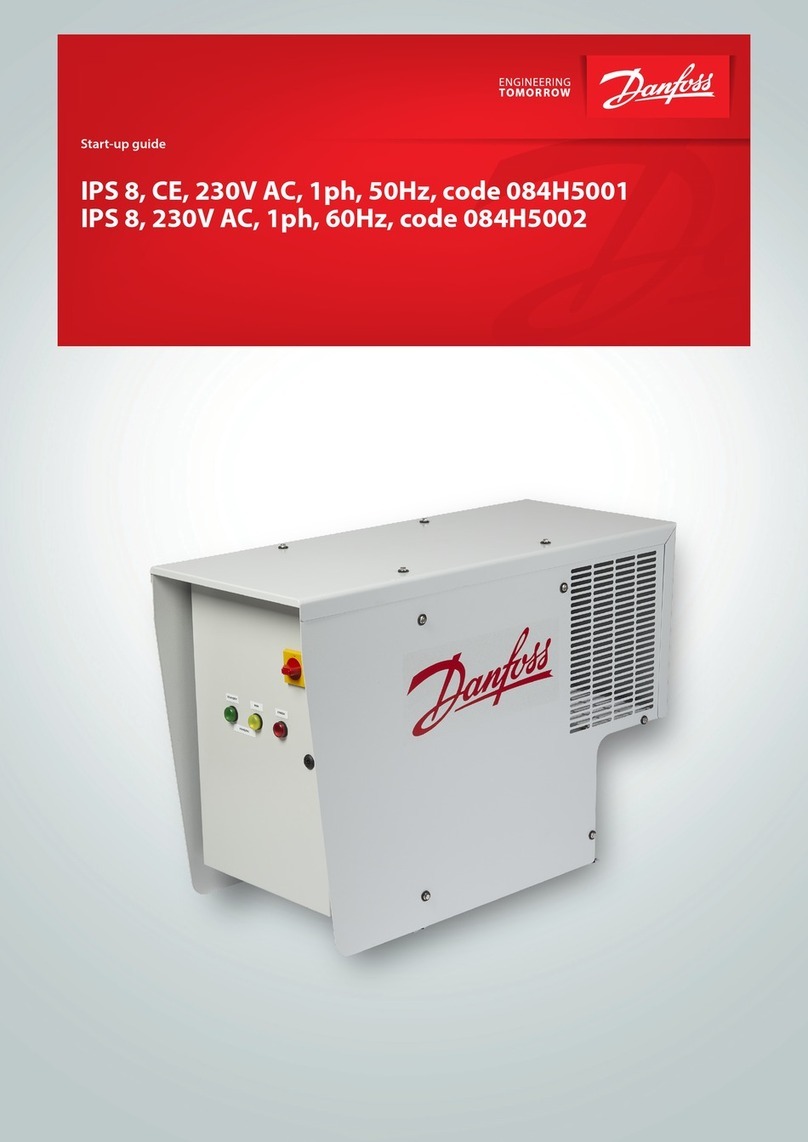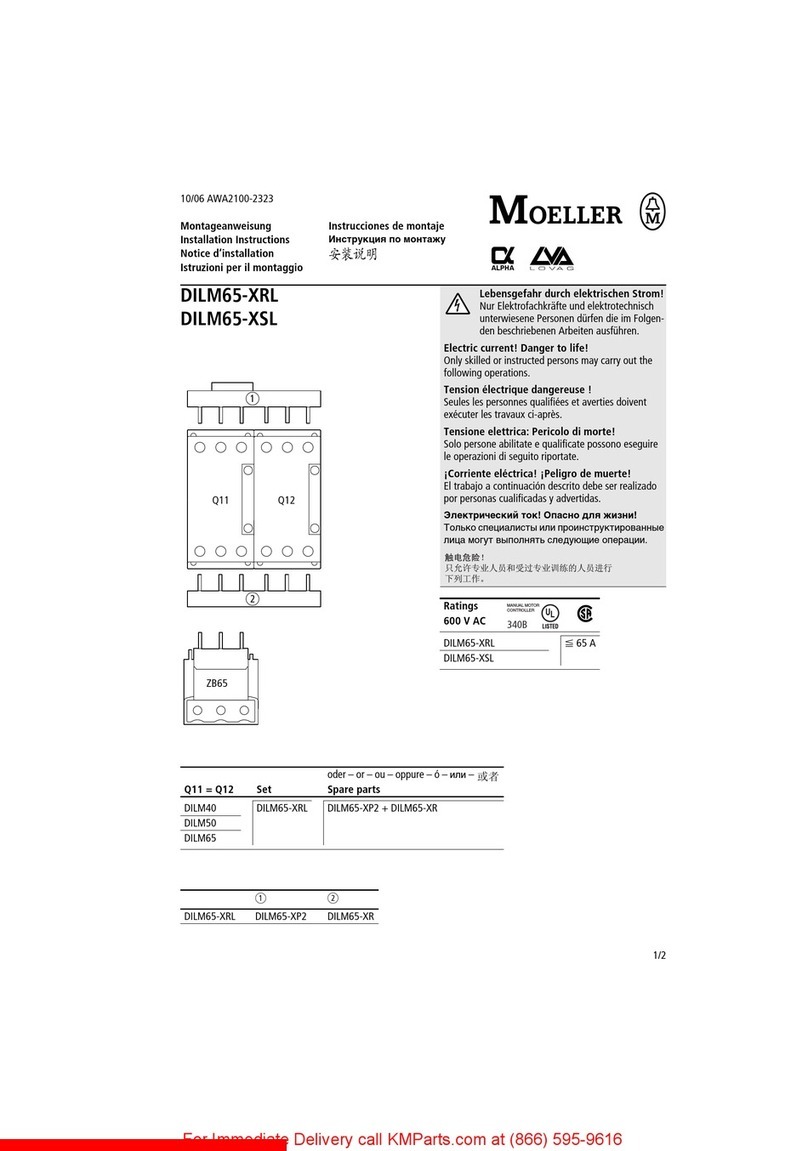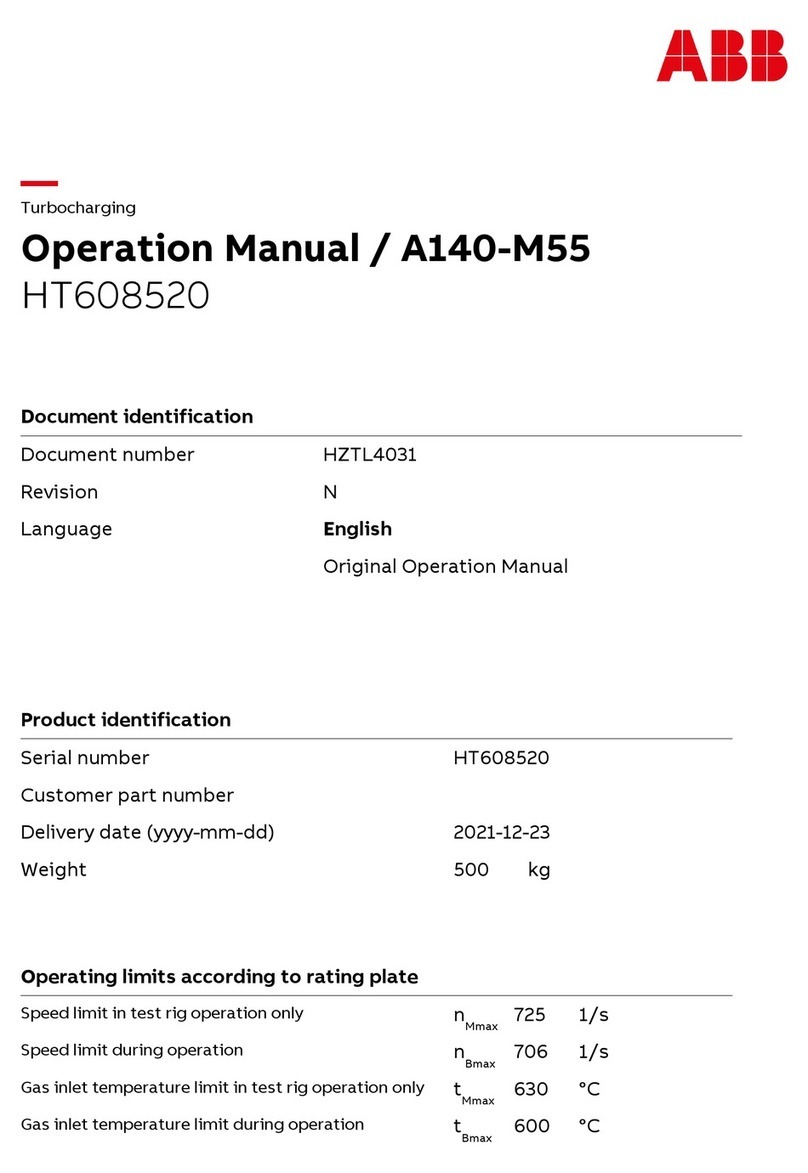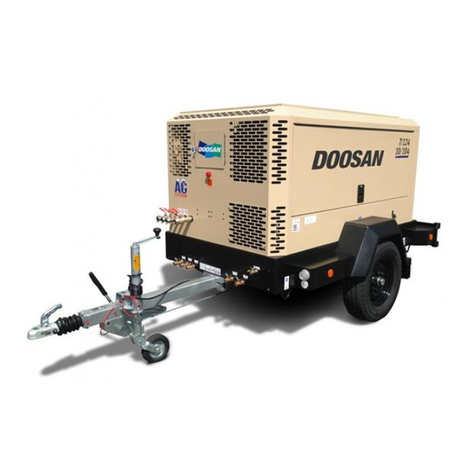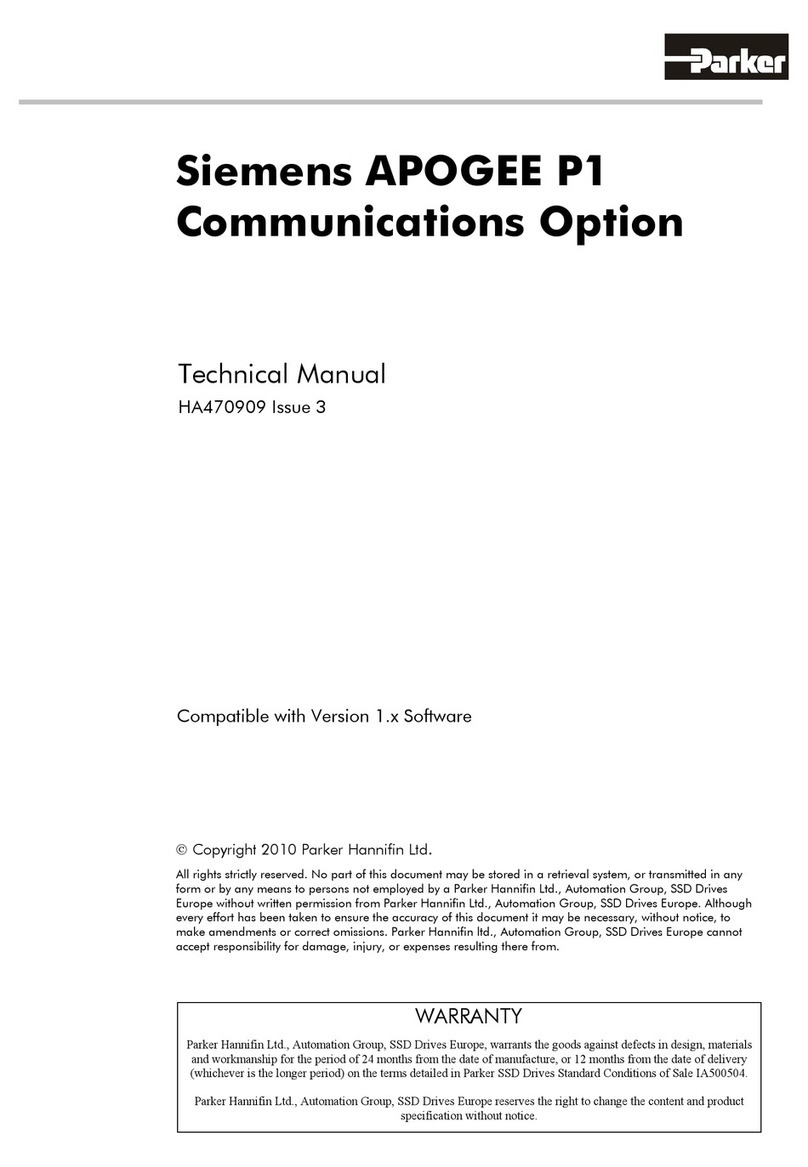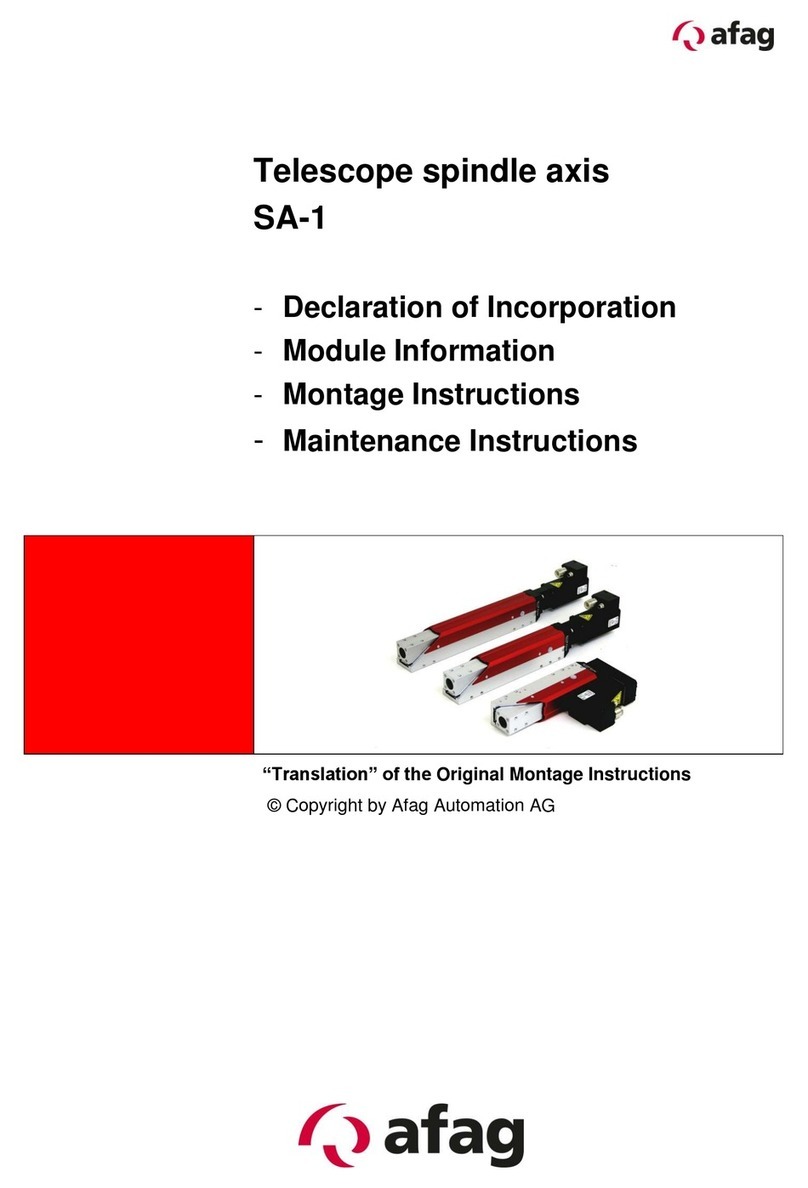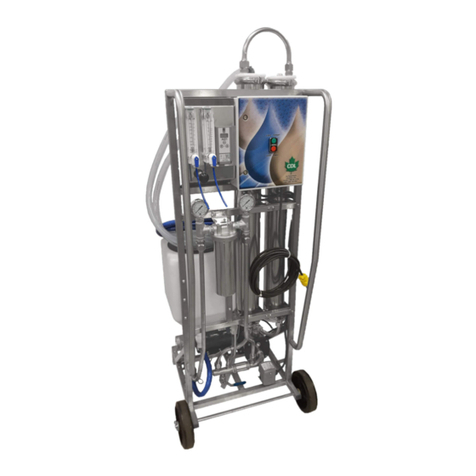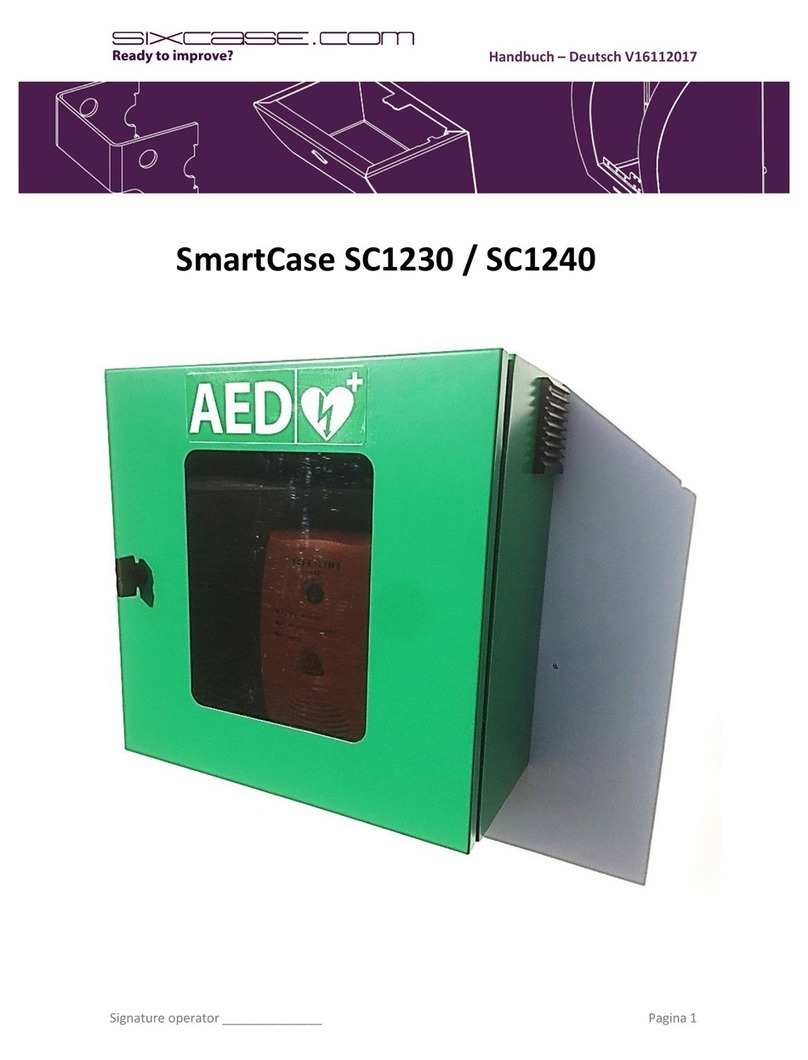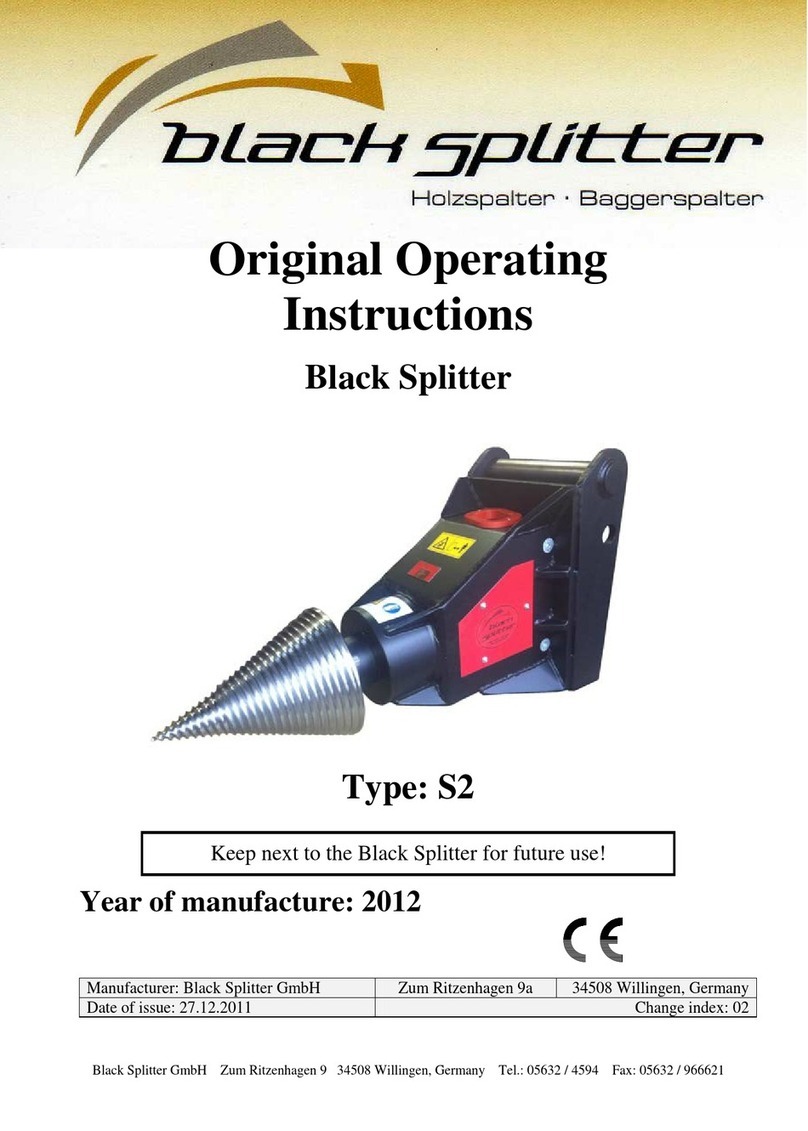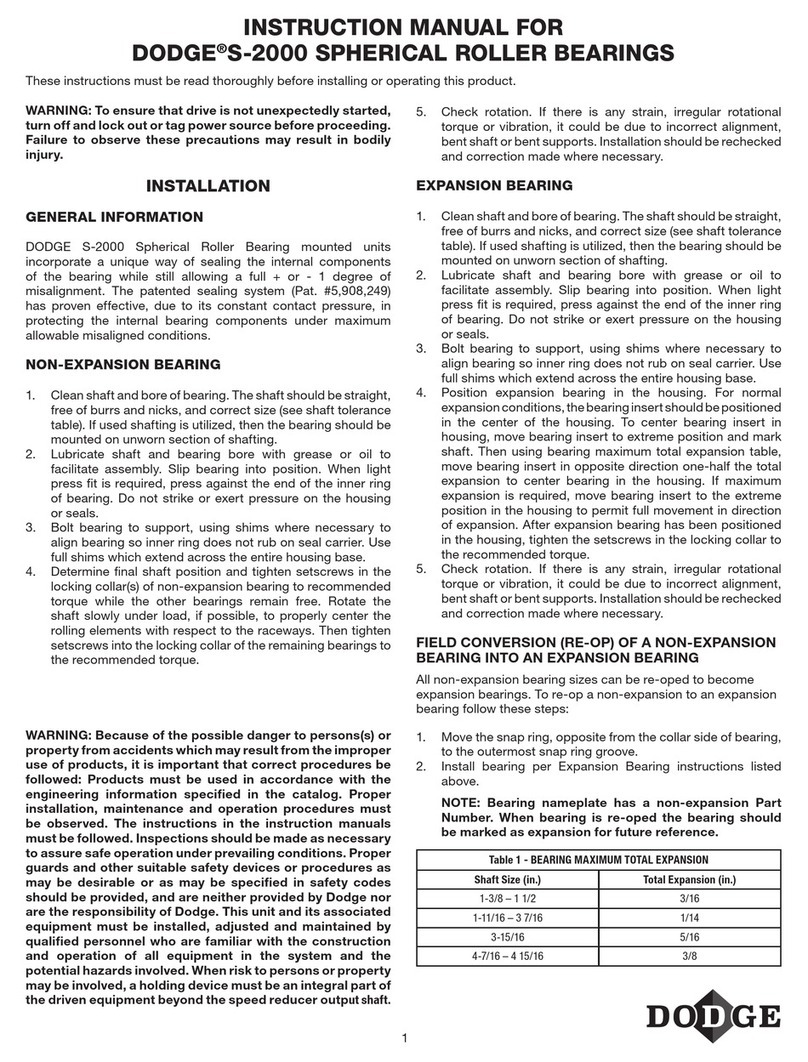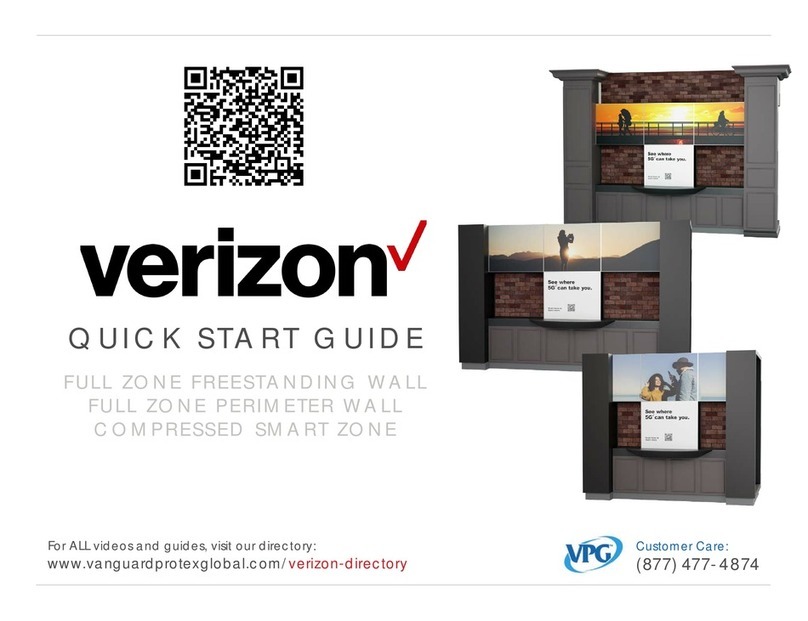Fueltec CF50E User manual

2017 Fueltec Model CF50E Fuel Polishing System
Fueltec Model CF50E
Mobile Fuel Polishing & Tank Cleaning Systems
Fueltec Systems LLC 828-212-1141
www.fueltecsystems.com
© LENZ 2017

2
2017 Fueltec Model CF50E Fuel Polishing System
WARNING
This product operates in the highly combustible atmosphere of a diesel or gasoline storage tank.
FAILURE TO COMPLY WITH THE FOLLOWING WARNINGS AND SAFETY PRECAUTIONS
COULD CAUSE DAMAGE TO PROPERTY, ENVIRONMENT, RESULTING IN SERIOUS INJU-
RY OR DEATH.
• This fuel polishing system should NEVER BE OPERATED inside a truck cargo body, enclosed
trailer, or within fifty (50) feet of an operating or hot engine, motor or fuel dispenser.
• All work must comply with the latest issue of the National Electrical Code (NFPA 70), the Code for
Motor Fuel Dispensing Facilities and Repair Garages (NFPA 30A), and any European, national,
state, and local code requirements that apply.
• When servicing unit, use non-sparking tools and use caution when removing or installing equipment
to avoid generating a spark.
• To protect yourself and others from serious injury, death, or substantial property damage, carefully
read and follow all warnings and instructions in this manual.
Warnings and Instructions
This section introduces the hazards and safety precautions associated with operating, maintaining or
servicing this product. Before performing any task on this product, read this safety information and the
applicable sections in this manual, where additional hazards and safety precautions for your task will
be found. Fire, explosion, or pressure release could occur and cause damage to property, environment,
resulting in serious injury or death, if these safe service procedures are not followed.
PRELIMINARY PRECAUTIONS
You are working in a potentially dangerous environment of flammable fuels, vapors, and fluid pressures. Only trained or
authorized individuals knowledgeable in the related procedures should operate, inspect, maintain or service this equipment.
Read the Manual
Read, understand and follow this manual and any other labels or related materials supplied with this equipment. If you do
not understand a procedure, call 1-828-212-1141 to locate a qualified technician. It is imperative to your safety and the safe-
ty of others to understand the procedures before beginning work. Make sure your employees and any service
contractors
read and follow the instructions.
Follow the Regulations
Applicable information is available in National Fire Protection Association (NFPA) 30A; Code for Motor Field Dispensing
Facilities and Repair Garages, NFPA 70; National Electrical Code (NEC), Occupational Safety and Hazard Association
(OSHA) regulations and federal, state, and local codes. All these regulations must be followed. Failure to operate, inspect,
maintain or service this equipment in accordance with these codes, regulations and standards may lead to legal citations
with penalties or affect the safe use and operation of the equipment. OSHA fall protection rules apply when working on
above ground fuel storage tanks.

3
2017 Fueltec Model CF50E Fuel Polishing System
Prevent Explosions and Fires
Fuels and their vapors will explode or burn, if ignited. Spilled or leaking fuels and used filters cause vapors. All used filters
should be promptly placed in an approved safety container until disposed of.
Even filling air compressor fuel tanks will cause potentially dangerous vapors in the vicinity of the work area.
Working Alone
It is highly recommended that someone who is capable of rendering first aid be present during operation. Familiarize your-
self with Cardiopulmonary Resuscitation (CPR) methods, while working around fuel vapors. This information is available
from the American Red Cross. Always advise other personnel about where you will be working, and caution them not to ac-
tivate power tools or engines while you are working with fuel filtration equipment. Use the OSHA Lockout/Tagout proce-
dures. If you are not familiar with this requirement, refer to OSHA documentation.
Hazardous Materials
Some materials may present a health hazard if not handled correctly. Ensure that you clean hands after handling equip-
ment. Do not place any equipment in the mouth.
FAILURE TO COMPLY WITH THE FOLLOWING WARNINGS AND SAFETY PRECAUTIONS
COULD RESULT IN PROPERTY DAMAGE, INJURY OR DEATH.
FIRE HAZARD!
Do NOT use power tools (Class I Division I and Class I Division II) during the operation or maintenance of equipment.
Sparking could ignite fuel or vapors, resulting in fire.
CHEMICAL EXPOSURE HAZARD!
Wear appropriate safety equipment during operation or maintenance of equipment. Avoid exposure to fuel and vapors.
Prolonged exposure to fuel may cause severe skin irritations and possible burns.
REQUIREMENTS FOR USE
• Fueltec fuel polishing and tank cleaning systems are designed for use only by trained personal. Free training is available
at Fueltec’s factory located in Granite Falls, NC USA. Call 1- (828) 212-1141
• The operation of Fueltec’s systems must be consistent with NFPA Code 30A, OSHA regulations, and federal, state and
local fire codes, and other applicable local regulations.
OPERATING PRECAUTIONS
• NO SMOKING. Extinguish all open flames and pilot lights, such as on RV appliances.
• TURN OFF cell phones and other electronic devices to prevent sparks which could cause an explosion or fire.
PERSONAL SAFETY
Stay alert, watch what you are doing and use common sense when operating or maintaining the system. Do not operate or
maintain the system while you are tired or under the influence of drugs, alcohol or medication. A moment of inattention
while operating or maintaining the system may result in serious personal injury or death.
Dress properly while operating this system. Do not expose bare skin or eyes to fuels. Prolonged contact with fuel can damage
the skin. Use safety apparel and equipment. Use safety goggles or safety glasses. Also use non-skid safety shoes, hardhat,
gloves, and fall protection when appropriate.

4
2017 Fueltec Model CF50E Fuel Polishing System
SAVE THESE INSTRUCTIONS
WORK AREA
• Mark work area with orange colored safety cones placed in a radius of at
least forty(40’) feet from fuel tank cleaning equipment, fuel
containers, and fuel tank openings.
• Place Flammable Liquid Warning Signs within work area
• Keep work area clean, free of clutter and well lit. Cluttered and
dark work areas can cause accidents.
• Keep children and bystanders away while operating this system.
Distractions can cause you to lose control, so visitors should re-
main at a safe distance of at least forty (40’) feet from the work
area.
• Be aware of all power lines, electrical circuits, water pipes and
other mechanical hazards in your work area, particularly those
hazards below the work surface hidden from the operator’s view
that may be unintentionally contacted and may cause personal
harm or property damage.
• Be alert of your surroundings. Using your system in confined work areas may put
you dangerously close to unsafe conditions.
• Keep one or more Fire Extinguishers U.L. rated 10A-80B:C in the work area.
• Keep electric cord plug ends at least 40 feet (40’) feet from fuel tank cleaning
equipment, fuel containers, and fuel tank openings.
40 ft.

5
2017 Fueltec Model CF50E Fuel Polishing System
Fueltec’s Fuel Polishing = water and parculate removal
Fuel is relavely clean when it leaves the renery, as it’s transported downstream it can
easily become contaminated with water, rust, silica, and bacteria. As a result the fuel
falls below the engine manufacturers recommended cleanliness levels. Fuel in storage
becomes even more contaminated with bacterial and fungi growth.
Fueltec’s fuel polishing systems rst stage primary bag lters remove parculates down
to one micron; the second stage lter/coalescer removes more parculates with an
inside to outside ow then coalesces ny water droplets into larger drops which stream
to the systems water trap. The third stage water separator prevents the water from
owing with the fuel with a Teon barrier. This is the same process and technology that
is used extensively on the puricaon of military and domesc jet fuel.
O-road diesel before polishing O-road diesel aer polishing

6
2017 Fueltec Model CF50E Fuel Polishing System
Fueltec Systems Model CF75.0 Mobile Fuel Polishing and Tank Cleaning System
Fuel polishing is the technical cleaning process; essentially the removal of water, sediment and
microbial contamination from such fuels as diesel.
Page 2.
Page 3. Index
Page 4.Operating procedure
Page 5. Safety
Page 6. CAUTION water separator housing air bleed
Page 7. Underground tank operation
Page 8. Separated water sight glass and drain
Page 9. Hose connection ports & Air bleed valve
Page 10. Three-way valve and Vacuum gauges
Page 11. Primary filter valves
Page 12. Primary filter change
Page 13. Water separator and coalescer change
Page 14. Specifications
Page 15. Fuel hose
Page 16. Static ground
Page 17. Fluid Pickup tube
Page 18. Supply and return to tank
Page 19. Contaminated diesel
Page 20. Microbes in fuel
Page 21. ISO 18/16/13 cleanliness target.
Page 22. BLANK
Page 23. Fuel Sampler
Page 24. HMI/PLC
NOT FOR GASOLINE, ETHANOL OR JET FUEL

7
2017 Fueltec Model CF50E Fuel Polishing System
Model CF50E OPERATING PROCEDURE
The Model CF50E is designed for use on fuel storage tanks with a capacity
greater than 1,500 gallons. Use on tanks smaller than 1,500 gal. could cause
emulsification.
1. Take a DIESEL fluid sample from the fuel tank’s bottom, (see page 24) to check for
water, sludge, rust, bacteria, fungi, or other particulates. Most contamination is heavi-
er than fuel and is normally found at the lowest 5%-10% of the storage tank.
2. First read and understand fuel handling safety requirements: 29 CFR Ch. XVII (7–1–10
Edition) and FLAMMABLE AND COMBUSTIBLE LIQUIDS (attached)
3. Attach the 2” x 25’ fluid supply hose to the primary filter manifold with cam and
groove fittings. Attach a fluid pickup tube to the opposite end of the hose, (page 11)
4. For bulk water removal attach the 2” x 25’ return to tank hose to the discharge port
nearest the diaphragm pump, (page 10).
5. To separate water from DIESEL fuel to less than 100 parts per million attach the 2” x
25’ return to tank hose to the water separator housing lower discharge port, (page 7.).
Attach the fluid discharge stinger to the tank end of the hose.
6. Check to see that the bag filters are secured in the primary filter housings, (page 12.)
7. Check to see that the five coalescers and two water separators are secured in the
water separator housing, (page 13.)
8. Open air bleed on the top of the water separator housing, (page 6) when air stops
escaping, close the valve.
9. BLANK
10.Open all four primary filter inlet and discharge valves by turning handles to a vertical
position, (page 11)
11.For filtration only or bulk water removal without the water separator, set 3-way valve
at diaphragm pump to discharge by rotating the handle to a horizontal position
12.For both primary filtration and water separation, set the 3-way valve at the diaphragm
pump to a vertical position. (page 10)
13.If the tank bottom water level is greater than three inches, pump the bulk water level
down to three inches with the CF50E set on filtration only, then set the system for wa-
ter separation, to remove water to less than 100 Parts Per Million.
14.Start system
15.As the water is being separated from the fuel, the level can be seen in real time in the
clear sight tube. (page 8.).
16.Drain the water from the pressurized water trap by opening the drain valve, (page 8.)
The separated water can be drained with out stopping the operation; and with no loss
of fuel in the process.
17.Primary filter bags can be changed without stopping the operation by closing the two
valves on one primary filter housing.
18.To drain fluid from the system after use, stop system, close primary filter supply
valves, (page_) close all return to tank valves, open primary filter air bleed valves,
open water drain valve after placing discharge hose in a waste container.
Start system. Stop system when fluid discharge stops from water drain hose.

8
2017 Fueltec Model CF50E Fuel Polishing System
WATER SEPARATOR AIR BLEED
The Model CF50E is equipped with an automatic and manual air bleed valves.
CAUTION: It is required that all air is removed from the water
separator housing for safe efficient operation.
Whenever the water separator function is used:
1. First open the manual air bleed valve which is located on the top cover of the water
separator housing.
2. Place 3-way fluid flow selector valve handle in a vertical position as shown on page
9 of this manual. This will direct fluid from the pump to the water separator
housing.
3. Clear the work area for a 50’ radius around the system before starting the pump.
4. When the pump is started you will hear air escaping from the manual air bleed
valve. USE EXTREAM CAUTION as this air may contain explosive fumes from
contact with fuel.
5. When air stops escaping from the manual air bleed valve, close the valve.
Manual Air Bleed Valve
Automatic Air Bleed Valve
NOT FOR GASOLINE, ETHANOL OR JET FUEL

9
2017 Fueltec Model CF50E Fuel Polishing System
CF50E Settings for Underground Storage Tanks
When separating water from fuel in underground fuel storage tanks always position the
return to tank valve so the pump pressure gauge reads a min. of 10 PSI.
This pressurizes the water separator housing so you can drain the separated water
without stopping the operation.
After starting the pump, rotate return to tank valve handle upward until the pump
pressure gauge reads 10 PSI.
Clean dry fuel return to tank valve

10
2017 Fueltec Model CF50E Fuel Polishing System
SEPARATED WATER DRAIN
The Model CF75.0 is equipped with a clear sight tube to observe water levels in real time as
moisture is separated from the fuel
Water can be drained while the system
is in operation by opening the drain
valve
Separated water level
The Fueltec Model CF50E Fuel Polishing System
• Exceeds engine manufacture’s cleanliness levels for tier four engines.
• Water separation flow rate 50 GPM, 3,000 gallons per hour
• Downstream free water level typically below (100) PPM
• Filtration flow rate 50 GPM, 3,000 gallons per hour
• Down to one (1) micron to meet ISO 4406 particle counts
• This system is designed for diesel only…. Not for fluid with a flash point
below 100 deg. F, gasoline, jet fuel, or ethanol
Clean dry fuel return to tank after
water separation

11
2017 Fueltec Model CF50E Fuel Polishing System
Sight Tube for
separated water
Primary Filters
inlet port
Water separated fuel
return to tank
valve port
Quick acting swing bolts
Water Separator
Housing
Quick Change swing bolt top covers
Filter Housing
Vacuum Gauge
Stainless Steel
Stainless Steel
Locking Casters 8”
Separator air bleed
valve
This system is designed for diesel only…. Not for fluid with a flash point
below 100 deg. F, gasoline, jet fuel, or ethanol

12
2017 Fueltec Model CF50E Fuel Polishing System
FILTER ONLY PORT
SELECTOR VALVE FOR FILTER ONLY OR FILTER AND WATER SEPARATION.
When all water has been separated and removed from the storage tank, operate three-way
valve to select lter only. Vacuum gauges will indicate condion of lter bags.
Filtered uid will ow from “FILTER ONLY PORT”
THREE-WAY VALVE OPERATION

13
2017 Fueltec Model CF50E Fuel Polishing System
Swing Bolt Eye Nut (hand tighten)
Vacuum Gauge
Primary Filters inlet port
Stainless steel
Primary filter housings
Primary Filter Air Bleed Valves
Primary Filter Supply
Valves
Primary Filter Discharge
Valves

14
2017 Fueltec Model CF50E Fuel Polishing System
1. Close inlet & outlet valves on left or right filter
housing.
2. Open top air bleed valve.
3. Loosen swing bolt eye nuts and remove housing
cover.
4. Remove bag filter hold down.
5. Remove and dispose soiled filter bag after each
use.
6. Insert new filter bag into housing and seat bag
flange on housing baffle plate.
7. Insert filter hold down.
8. Install filter housing cover and swing bolts into
slots in cover.
9. Tighten swing bolt eye nuts hand tight then 1/4
turn more. (do not over tighten)
13. Close air bleed valve and open inlet & outlet valves
14. Resume operation.
PRIMARY FILTER REPLACEMENT
The Model CF50E Mobile has two independent primary bag filters within stainless steel
housings. Each filter can be changed without stopping the system by closing the respec-
tive supply and return valves.
Note:
Change primary filter bags when vacuum gauge
reads 15”

15
2017 Fueltec Model CF50E Fuel Polishing System
1. Stop the system.
2. Close outlet valve at bottom of water separator
housing.
3. Close inlet valves on primary bag filter housings.
4. Loosen swing bolt eye nuts and remove housing
cover.
5. Remove fastener wing nuts and remove and
replace coalescer cartridges.
6. Replace fastener wing nuts hand tight.
7. Inspect O-ring cover seal
8. Install filter housing cover and swing bolts into
slots in cover.
9. Tighten swing bolt eye nuts hand tight then 1/4
turn more. (do not over tighten)
13. Open inlet & outlet valves
14. Resume operation.
WATER SEPARATOR/ COALESCER CARTRIDGE REPLACEMENT
The Model CF50E Mobile has five coalescer and two water separator cartridges within a
stainless steel housing.
Note:
Change coalescer cartridges when pressure gauge
on the fuel pump reads 20 PSI

16
2017 Fueltec Model CF50E Fuel Polishing System
Item SPECIFICATIONS Model CF50E
1Chassis Steel and Aluminum Standard
2 Fuel Pump flow rate* 3,000 GPH
3Pump motor 5 HP 230v 1 PH 50/60 Hz Standard
4Maximum Lift wet 20 feet
5Bag Filters in Stainless Steel Housings two (2) ea. 24 inch bag
6Fuel Pressure Working Max. 60 PSI
7Supply & Return Fuel Hose with cam-lock connectors 2 in. x 25 ft. each
8Filter Condition Vacuum Gauges One each housing
9Touch screen HMI/PLC with pressure, vacuum, and water sensors Standard
10 Static Ground Safety Reel Standard
11 Flat Free 8 in. Casters Standard
12 Stainless Steel Water Separator Housing Standard
13 Supply & Return Ball Valves Standard
14 Quick Change Swing Bolt Housing Covers Standard
15 Coalescer Elements five (5) ea. Standard
16 Water Separator Elements two (2) ea. Standard
17 Width X Length X Height.. Lbs. 47x47x60..550lbs.
WARNING: Read carefully and understand all
INSTRUCTIONS before operating. Failure to follow the safety
rules and other basic safety precautions may result in serious
personal injury, or death.
It is important that you read the entire manual to become familiar with this product before you begin using it.
This machine is designed for certain applications only. FuelTec Systems cannot be responsible for issues arising
from modification. We strongly recommend this machine is not modified and/or used for any application other than
that for which it was designed. If you have any questions relative to a particular application, DO NOT use the
machine until you have first contacted FuelTec Systems to determine if it can or should be performed on the
product.
NOT FOR GASOLINE, ETHANOL OR JET FUEL
* Flow rates may vary with compressed air supply, filter type and condition, length and size of hoses, and
size and shape of fluid pickup and return tubes.
General Safety Regulations
WARNING: Maximum pressure not to exceed sixty (60) psi.
WARNING: The warnings, cautions, and instructions discussed in this instruction
manual cannot cover all possible conditions or situations that could occur. It must be
understood by the operator that common sense and caution are factors which cannot be built into this product,
but must be supplied by the operator.

17
2017 Fueltec Model CF50E Fuel Polishing System
Supply & Return Hoses… The Systems come with two (2) 2” X 25’ hoses
equipped with cam lock fittings and adaptors.
Fabricate suction tubes of the proper length to reach the tank bottom you are
servicing.
Suction and return tubes can be fabricated from PVC, Aluminum, Stainless
Steel, or iron pipe. Flexible suction tubes can be made from polyurethane tube,
nylon 11 tube, and PTFE (Teflon) tube.

18
2017 Fueltec Model CF50E Fuel Polishing System
FUEL TANK SAFETY
• Purge fuel tank (fill airspace inside the tank between any fuel and the top of
the tank) with argon or CO2 prior to drilling or sawing holes that penetrate the
tank to minimize the risk of explosion.
• Maintain a purged condition while installing fittings on a fuel tank.
STATIC GROUND
• Always attach a static discharge cable from the Fueltec System to the fuel
tank being serviced.
The flowing movement of flammable liquids inside a pipe can build up static electricity.
Non-polar liquids such as gasoline, diesel, kerosene and light crude oils exhibit signifi-
cant ability for charge accumulation and charge retention during high velocity flow.
Static electricity can discharge into a fuel vapor. When the electrostatic discharge en-
ergy is high enough, it can ignite a fuel vapor and air mixture. Different fuels have dif-
ferent flammable limits and require different levels of electrostatic discharge energy to
ignite.
. The use of a static discharge cable can help to prevent or safely dissipate the build
up of static electricity.

19
2017 Fueltec Model CF50E Fuel Polishing System
TYPE “D” CAM-LOCK INCLUDED WITH SYSTEM
FUELTEC’S FUEL SUCTION HOSE
FLUID PICKUP TUBE MADE IN FIELD TO REACH
FUEL STORAGE TANK BOTTOM.
TUBE CAN BE MADE FROM STEEL PIPE, ALUMINUM,
STAINLESS STEEL, PVC, NYLON-6, POLYURETHANE,
OR ANY MATERIAL IMPERVIOUS TO THE FUEL
THAT YOU ARE IN CONTACT WITH.
CUT TUBE BOTTOM AT 30 DEGREES
FUEL TANK BOTTOM
ATTACH PICKUP TUBE TO CAM-LOCK “D” WITH A
STREET ELBOW FITTING
FLUID PICKUP TUBE BUILDING FOR FUELTEC’S MOBILE SYSTEMS

20
2017 Fueltec Model CF50E Fuel Polishing System
SUCTION HOSE
RETURN TO TANK HOSE
FUEL TANK BOTTOM
SLUDGE
CLEAN DRY FUEL RETURNING TO
TANK THROUGH JET NOZZLE
AT 60 PSI WILL LOOSEN SLUDGE
SUCTION INTAKE ON
TANK BOTTOM
SLUDGE BUSTER
OPERATION WITH
JET NOZZLE
Table of contents
Other Fueltec Industrial Equipment manuals

